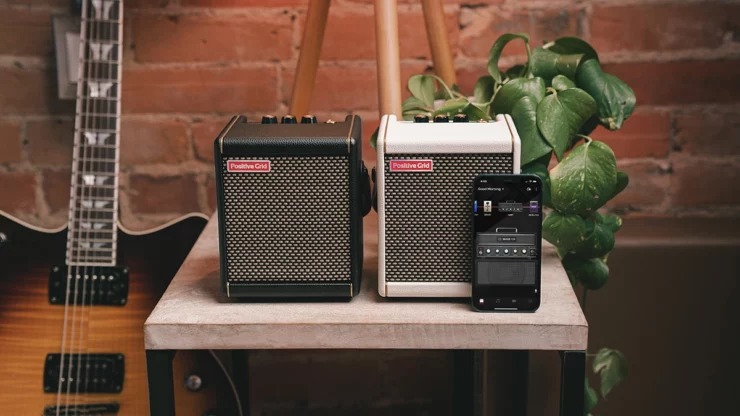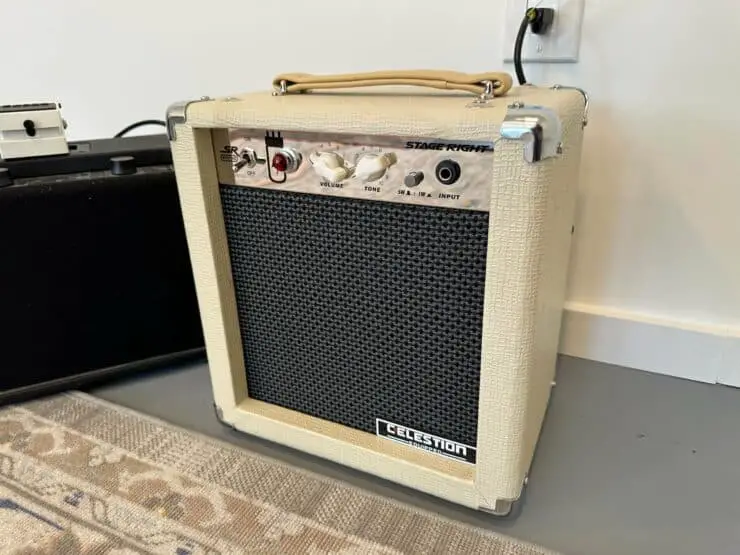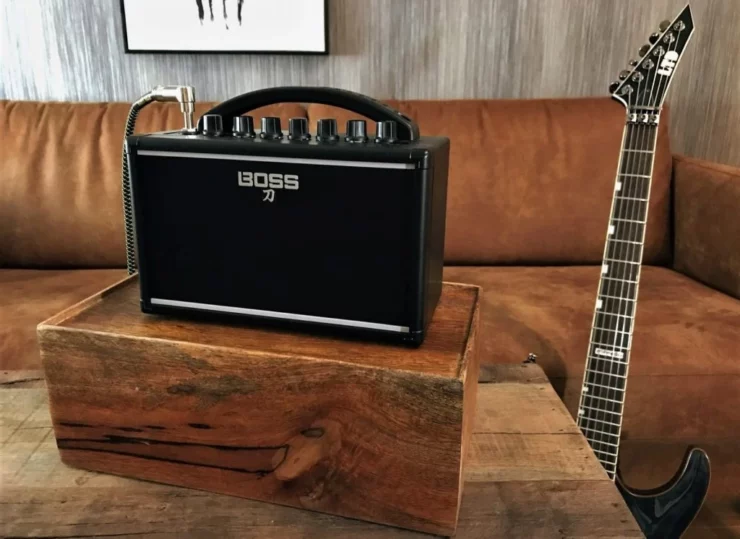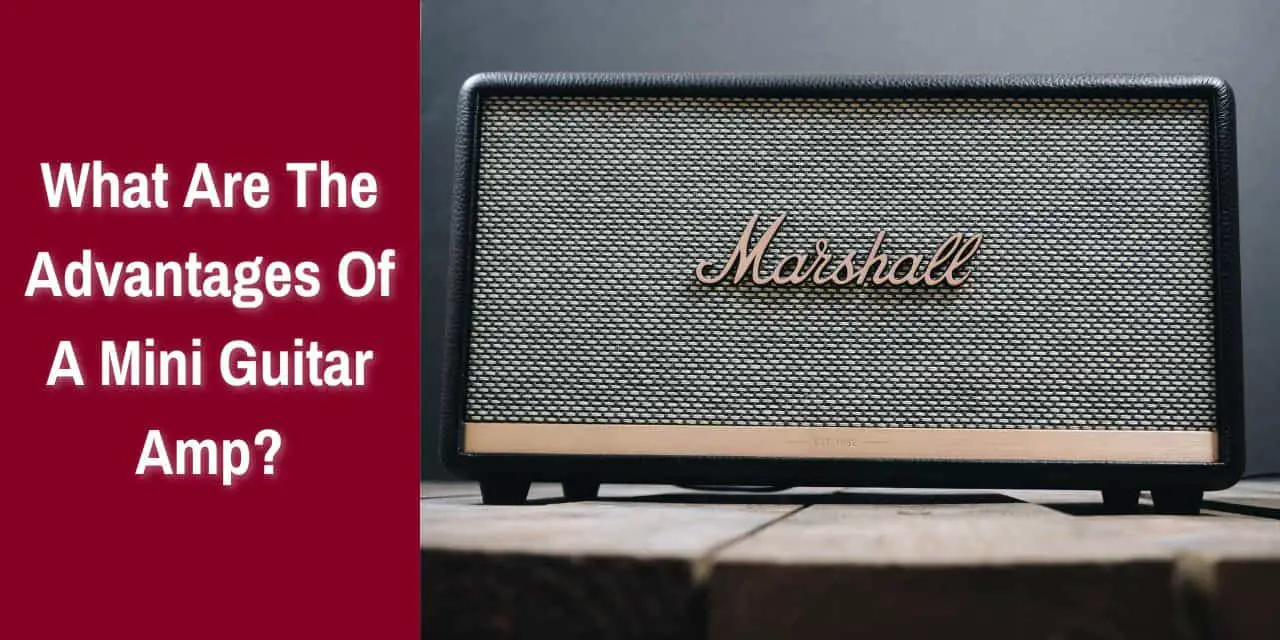Are you a guitar player looking for a smaller amp to bring with you while you travel? Or maybe you’re looking for an amp that won’t take up too much space in your bedroom. Whatever your situation, a mini guitar amp is the perfect solution! In this article, we will explore the advantages of mini guitar amps and why they are becoming increasingly popular amongst guitar players. Read on to discover why you should consider investing in a mini guitar amp for your next performance.

What is a Mini Guitar Amp?
For guitar enthusiasts, the world of amplification is an important part of their musical journey. While traditional guitar amps are well-known, the emergence of mini guitar amps has added a new dimension to portable and convenient amplification.
A mini guitar amp or also known as a portable guitar amp or a practice amp is a smaller and more compact version of a traditional guitar amp. It is designed for mobility, convenience, and ease of use, which makes it an ideal choice for musicians who require amplification on the go or for practice sessions. Despite its small size, a mini guitar amp is capable of delivering a decent amount of volume and tone, allowing guitarists to achieve a desirable sound without the need for larger and bulkier setups.
>>> Click here to read our review about the Top 15 Best Mini Guitar Amps <<<
The functionality of a mini guitar amp is similar to that of its larger counterparts. It consists of essential components such as preamp circuits, power amps, and speakers. These components work together to amplify the signal from an electric guitar and produce sound with the desired tonal characteristics.
When a guitar is connected to a mini guitar amp, the signal from the guitar’s pickups is sent to the preamp circuit. The preamp circuit adjusts the tone and volume of the signal, allowing the guitarist to shape their desired sound. This can include adjustments to bass, treble, midrange, and gain settings depending on the features of the specific mini guitar amp.
Once the signal is processed by the preamp circuit, it’ll be passed to the power amp. The power amp will boost the signal to a level that is suitable for driving the speaker. The power output of a mini guitar amp is typically lower than that of a full-sized amp but it is still sufficient for practice sessions, small performances, or private rehearsals.
The speaker, an important part of any amp, is responsible for projecting the amplified guitar sound. Mini guitar amps often feature built-in speakers, ranging in size from a few inches to around 8 inches in diameter. The size of the speaker will impact the overall sound quality, with larger speakers typically providing more depth and clarity.
Mini guitar amps also offer additional features and functionality depending on the model and brand. These can include built-in effects such as delay, reverb, distortion, and modulation, as well as headphone outputs for silent practice. Some amp models also offer battery operation, making them truly portable and suitable for outdoor performances or busking. Brands like Boss, Vox, etc. have stunning lineups of mini guitar amps.
What are the advantages of a mini guitar amp
For musicians and guitarists, the world of amplification is important for achieving their desired tone and projecting their sound. While traditional guitar amps offer powerful amplification, the emergence of mini guitar amps has opened a new realm of convenience and portability. These compact and portable devices bring with them a whole host of advantages that cater to the needs of musicians on the go. Here are some of the primary benefits of using a mini guitar amp and why they’ve become so popular among musicians and guitarists –
#1. Portability
The most obvious advantage of a mini guitar amp is its portability. These compact devices are designed to be lightweight and easy to carry, which makes them ideal for musicians who are constantly on the move. Whether you are heading to a jam session, a small gig, or just practicing in different locations, a mini guitar amp will allow you to take your amplified sound wherever you go. Its compact size means that it can fit into a backpack, gig bag, or be hand-carried, providing unmatched convenience and flexibility.
#2. Practice anytime, anywhere
Mini guitar amps are perfect for practice sessions. These amps allow you to plug in your guitar and practice with amplified sound without disturbing those around you. Many models also feature a headphone output, enabling silent practice. This is especially useful for late-night or apartment dwellers who want to maintain good relations with neighbors while honing their guitar skills.
#3. Versatility
Despite their small size, mini guitar amps are surprisingly versatile. They typically come with a range of tone-shaping controls such as bass, treble, and midrange adjustments as well as gain and volume knobs. Some models also include built-in effects like delay, reverb, and more, providing a wide range of sonic possibilities. This versatility will allow you to experiment with different tones and create your desired sound, all within a compact and portable package.
#4. Easy setup
Setting up a mini guitar amp is a breeze. With fewer cables and connections to worry about compared to larger amps, you will be up and running in no time. You should simply plug in your guitar, adjust the settings to your preference and you will be ready to play. This simplicity and ease of use make mini guitar amps ideal for quick jam sessions, impromptu performances, or when you’re short on time.

#5. Cost-effective
Mini guitar amps are often more affordable than their larger counterparts. This makes them a great option for beginners or those on a budget who still want to experience the benefits of amplified sound. They provide a cost-effective way of practicing, experimenting with different tones, and enhancing your playing experience without breaking the bank.
#6. A valuable tool for recording and home studios
Mini guitar amps can be a valuable tool for recording and home studio setups. Their compact size and ease of use will make them a convenient solution for capturing guitar tracks without the need for a full-sized amp. They can be integrated easily into a recording setup, allowing you to lay down tracks with minimal fuss.
Different types of mini guitar amps
Mini guitar amps have truly revolutionized the way musicians and guitarists practice, perform, and record their music. These compact and portable devices offer convenience, versatility, and amplified sound in a small package. With the growing popularity of mini guitar amps, manufacturers have developed different types to cater to the diverse needs of guitar enthusiasts. Here are the different types of mini guitar amps available on the market and their unique features.
Tube mini guitar amps
Tube mini guitar amps might be slightly rare in the mini amp category, but they’re still known to offer the warmth and rich harmonics associated with traditional tube amps. These guitar amps use vacuum tubes in the preamp and power amp sections, providing a classic and dynamic tone. Mini tube amps are favored by guitar purists who appreciate the organic and responsive nature of tube-driven sound. They often feature a significant While tube mini guitar amps are typically associated with larger, high-powered amps, there are also mini versions available that capture the essence of their higher counterparts.
Tube amps are known for their distinct tonal qualities, characterized by smooth overdrive, responsive dynamics, and rich harmonics. They offer a warm and natural sound that many guitarists find appealing. They’re highly responsive to changes in playing technique and guitar volume. They also offer touch sensitivity, allowing players to achieve expressive and nuanced performances.
Tube mini guitar amps truly excel at producing natural, pleasing overdrive when pushed to higher volume levels. This saturation and distortion are highly sought after by guitarists looking for classic blues, rock, or vintage-inspired tones. These amps often replicate the iconic design of their larger counterparts, with stacked knobs, grill cloth, and retro-style appearance. This aesthetic appeal can be an added bonus for guitarists who appreciate the vintage-inspired look.
Solid-state mini guitar amps
Solid-state mini guitar amps employ transistor-based circuitry to amplify the guitar signal. These amps are known for their reliability, versatility, and affordability. They have gained popularity among guitarists who seek a more consistent and practical solution without the maintenance requirements of tube amps.
Solid-state mini guitar amps are built to be robust and reliable, with no tubes to replace or burn out. They can withstand frequent transportation and the rigors of touring. Solid-state amps offer consistent sound reproduction and tonal accuracy. They are less prone to tonal variations by aging tubes and offer a more predictable and consistent performance.
Solid-state mini guitar amps are typically more affordable than their tube counterparts, making them a popular choice for budget-conscious guitarists. They can produce a wide variety of tones, from clean and pristine to heavy distortion. Moreover, they also come with built-in effects and tone-shaping options, providing versatility for different musical genres and playing styles.
Digital-modeling mini guitar amps
Digital-modeling mini guitar amps make use of digital signal processing technology for emulating the sound and response of various classic amps. These amps offer an impressive range of built-in amp models, effects, and customizable settings, allowing guitarists to explore a multitude of sounds within a single unit.
They also provide access to a vast range of amp models, allowing guitarists to experiment with different tones and styles. They often include presets that emulate iconic amps, which makes it easy to dial in specific sounds. Digital-modeling mini guitar amps typically come with a wide selection of built-in effects, such as delay, reverb, modulation, and more. This eliminates the need for additional pedals, streamlining your setup.
Many digital-modeling mini guitar amps offer direct recording capabilities and headphone outputs, which make them perfect for home recording or silent practice sessions. They often come with USB connectivity, allowing easy integration with recording software and digital workstations. They’re compact and lightweight, which makes them highly portable and convenient for on-the-go musicians.

Hybrid mini guitar amps
Hybrid amps combine the characteristics of both tube mini guitar amps and solid-state mini guitar amps. They typically make use of solid-state technology in the preamp section and incorporate a tube in the power amp section. This hybrid design aims to achieve a balance between the reliability and affordability of solid-state amps and the warmth and responsiveness of tube amps. Hybrid mini guitar amps offer a compromise between different tonal characteristics, providing a unique sonic experience.
Battery-powered mini guitar amps
Battery-powered mini guitar amps offer the ultimate portability and convenience. They run on batteries, making them ideal for busking, outdoor performance, or situations where access to a power outlet is limited.
Despite their small size, battery-powered mini guitar amps will deliver a surprising amount of volume and sound quality. They are perfect for musicians and guitarists who need amplification on the go and want to play anywhere without the need for external power sources.
Practice mini guitar amps
Practice mini guitar amps are designed with the needs of home and practice sessions in mind. These amps typically come with lower wattage, which makes them suitable for lower-volume settings. Practice mini guitar amps typically come with headphone outputs, allowing for silent practice without disturbing others. They’re quite compact, lightweight, and straightforward to operate, which makes them a great choice for beginners, students, or guitarists who primarily play practice at home.
How to choose a mini guitar amp?
When it comes to selecting a mini guitar amp, there are a number of factors to consider. Each element plays an important role in shaping your overall playing experience. Here are some of the key features that you should consider as they’ll help you make a smart decision when choosing a mini guitar amp that suits your needs and preferences.
Power rating
The power rating of a mini guitar amp will determine its output volume and overall performance. While mini guitar amps typically have lower wattage compared to larger amps, they can still offer sufficient volume for practice sessions and small gigs.
You should consider your intended usage, whether you require an amp for home practice or occasional performances, and choose a power rating that suits your requirements. Remember that higher wattage does not necessarily mean better sound quality as other factors like speaker size and construction will also contribute to the overall tone.
Speaker size
The size of the speaker in a mini guitar amp will directly influence the sound projection and tonal characteristics. Smaller speakers, such as 4 to 6-inch models are compact and suitable for personal practice or low-volume playing.
They can still produce decent sound but with less low-end and overall depth. Meanwhile, larger speakers like 8 to 10-inch versions offer a more robust bass response and a fuller tone. Consider the type of music you play and the sound that you want to achieve when choosing a speaker size.
Tone controls
The tone controls on a mini guitar amp allow you to shape the sound to your liking. Common tone control knobs include bass, treble, and midrange, which allow you to adjust the frequency response of the amp. Some amps might also have additional EQ options or voicing switches, providing further flexibility in shaping the tone. Experimenting with these controls will help you find the sweet spot that complements your playing style and instrument.
Effects
Many guitar amps offer built-in effects that allow you to enhance the sound without the need for external pedals. These effects include reverb, chorus, delay, modulation, and distortion, among others.
Having onboard effects can be quite convenient, especially for practice or small performances where portability and simplicity are key. However, if you already own a collection of effects pedals, you might prefer an amp with a straightforward signal path and focus on providing a clean, transparent tone.
Connectivity
Connectivity options also play a significant role in how you integrate your mini guitar amp with other devices and equipment. You should look for features with auxiliary inputs, headphone outputs, and line outputs.
An auxiliary input will allow you to connect external audio sources like smartphones or MP3 players, allowing you to jam along with your favorite tracks. A headphone output is useful for silent practice, while a line output will allow you to connect to recording devices or mixers for direct recording or live performance purposes.
Additional features
Some mini guitar amps might come with additional features to enhance your playing experience. This can include features like a built-in tuner, metronome, or rhythm accompaniments. These extras will be helpful for practice sessions and offer added convenience but they might not be essential for everyone. You should consider your specific needs and whether these features align with your playing style and goals.
How to use a mini guitar amp?
Mini guitar amps have become increasingly popular among musicians and guitarists due to their portability, versatility, and convenience. These compact devices offer a wide range of possibilities, from practice sessions in the comfort of your own home to capturing guitar tracks in a recording studio. Here are the different ways to use a mini guitar amp and incorporate it into your recording workflow.
Setting up your mini guitar amp
First, you should know how to set up a mini guitar amp. Setting a guitar amp is a straightforward practice that will allow you to unleash its potential. Look for a stable surface where you can place your mini guitar amp, ensuring that it is at a comfortable height for easy access to the controls and connections.
Then, plug your guitar into the input jack of the mini guitar amp using a standard instrument cable. Make sure that is a secure connection to avoid any unwanted noise or interference. Depending on the model, your mini guitar amp might be powered by batteries or an AC adapter. Follow the manufacturer’s instructions to ensure proper power supply and connect the amp accordingly.
Set the volume to a low level to avoid any sudden loud surprises. Experiment with the tone controls such as bass, treble, midrange to shape your desired sound. Play your guitar and listen to the sound produced by the mini guitar amp. Make any necessary adjustments to the volume, tone controls, or other settings until you achieve the desired tone and volume balance.
Using a mini guitar amp for practice
Mini guitar amps are perfect for practice sessions, providing a convenient and portable solution. To enhance your practice experience with a mini guitar amp, you can carry out silent practice, use built-in effects, play along with backing tracks, and more.
If you need to practice silently, many mini guitar amps come with a headphone output. You should just plug in your headphones and enjoy playing without disturbing others. This feature is especially useful for late-night practice or when privacy is required.
Many mini guitar amps come with built-in effects, such as reverb or delay. Experiment with these effects to enhance your playing and explore new sonic possibilities. However, you should remember that simplicity will be key during practice, so you shouldn’t rely too heavily on effects and focus on honing your technique and musicality.
Make use of the auxiliary input on your mini guitar amp to connect external devices like smartphones or MP3 players. Play along with your favorite songs or backing tracks to improve your timing, improvisation, and overall performance skills.
While mini guitar amps can produce decent volume, they are primarily designed for low-volume practice. You should be mindful of your surroundings and adjust the volume accordingly. If you need more power for band rehearsals or live performances, you should consider using your mini amp in conjunction with a PA system or large amp.
Using a mini guitar amp for recording
Mini guitar amps could be a valuable tool in your recording setup, allowing you to capture the guitar tracks with ease. You should consider incorporating your mini guitar amp into your recording workflow but keep certain things in mind like mic placement, combining with amp simulations, and experimenting with close and distant miking.
Position a microphone in front of your mini guitar amp’s speaker to capture the sound. Experiment with microphone placement to find the sweet spot that captures the desired tone and balances the levels between the guitar and other instruments.
If your mini guitar amp features a line output, you’ll be able to connect it directly to an audio interface or record your device. This method will allow you to bypass microphones and capture a clean, direct signal from your amp.
If you prefer using amp simulation plugs or software, you’ll be able to connect the line output of your mini guitar amp to your recording setup and process the sound further using digital effects and amp emulations.
Depending on the sound that you want to achieve, you should try both close miking (placing the mic near the speaker) and distant miking (placing the mic further away) techniques. Each method will offer distinct sonic characteristics and allow for creative possibilities during the mixing process.
FAQs
What are the advantages of a mini guitar amp?
Mini guitar amps are a great choice for practice and are known for their portability and convenience. They are typically smaller and lighter than regular amplifiers and can easily fit in a backpack or a guitar case. Mini amps are also typically more affordable than regular amplifiers, making them a great option for guitarists on a budget.
What types of mini amps are available?
There are several types of mini amps available, including solid state amps, modeling amps, and portable amps. Each type of amp has its own unique sound, features, and benefits, so it’s important to consider which type of amp is best for your needs.
What should I consider when choosing a mini amp for practice?
When choosing a mini amp for practice, you should consider the type of guitar and playing style, volume and tone control, power and speaker size, budget, and portability needs. It’s important to find the right balance of these factors to ensure you get an amp that meets your needs and provides a great playing experience.



